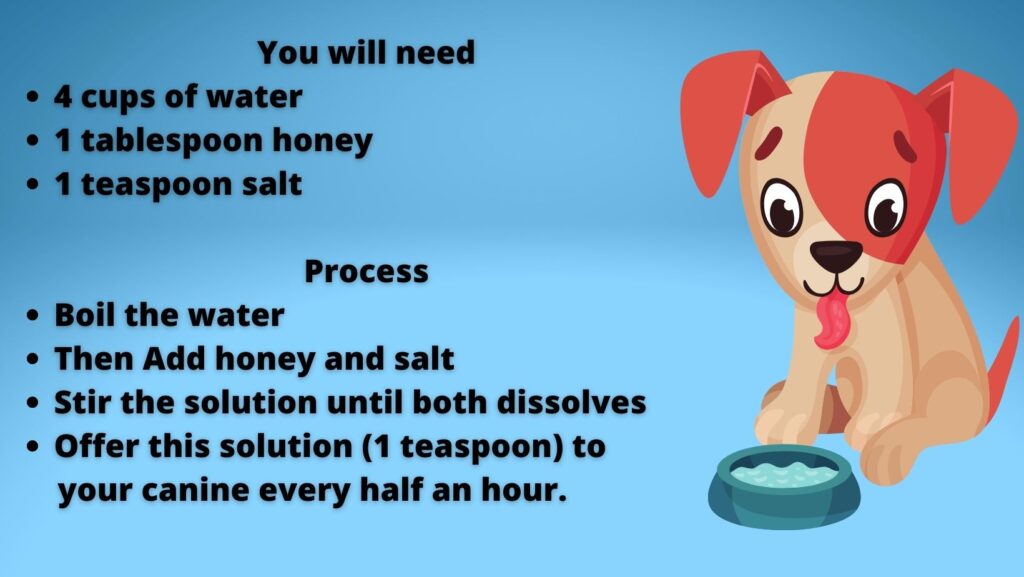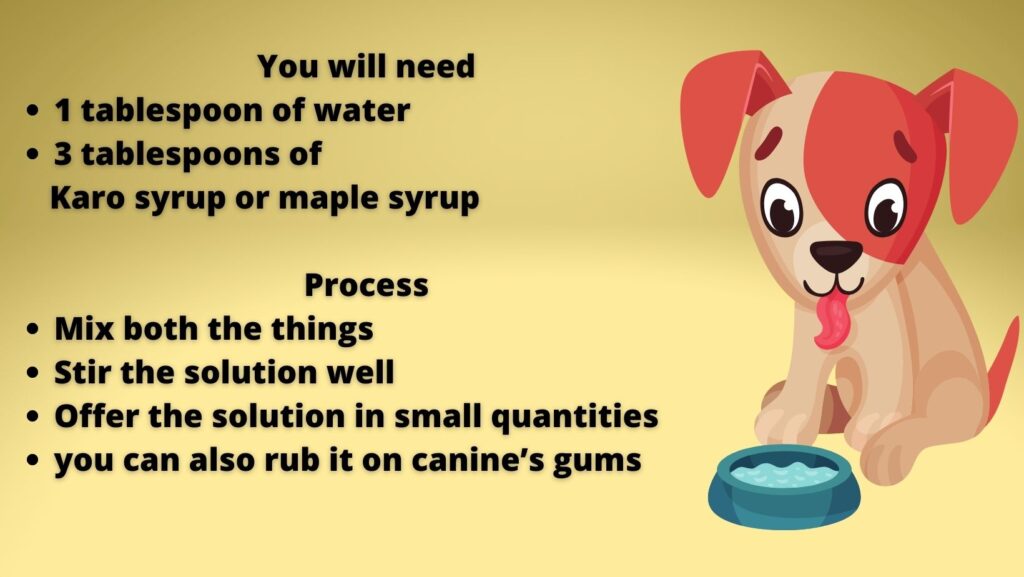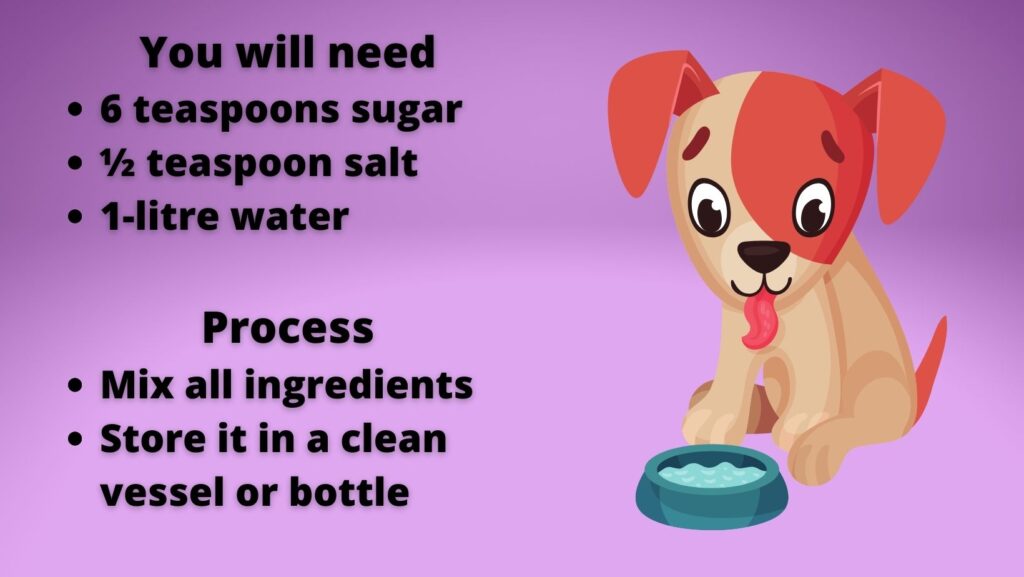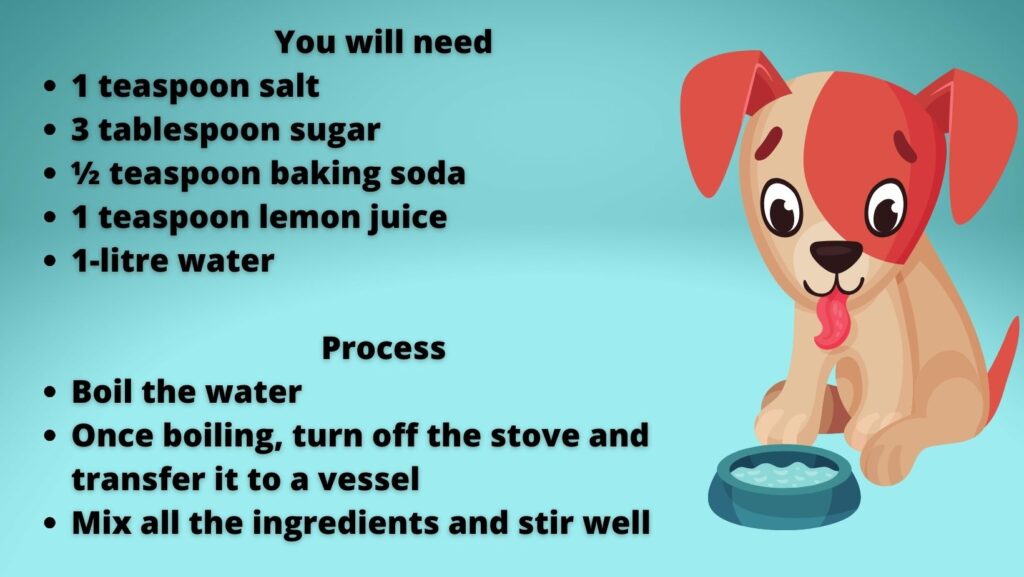In today’s article, we will talk about how you make sugar water for dogs and puppies. To be honest, this is the easiest thing to make. Moreover, sugar water is the best quick remedy for hypoglycemia.
Canines of all breeds can experience hypoglycemia, in any other case called low blood sugar. However, small and toy canine breeds, like Pomeranians, Chihuahuas, and Yorkshire terriers, are more at risk.
The best and easiest way to deal with it is to feed sugar water to the canine. In fact, it works best when hypoglycemia is in its initial stage.
Moreover, there are different methods on the internet for making sugar water for dogs and puppies. Some of them are listed below-
Contents
Method 1-( Using honey)
You will need
- 4 cups of water
- 1 tablespoon honey
- 1 teaspoon salt
Process
- Boil the water
- Then add honey and salt
- Stir the solution until both things dissolve
- Offer this solution (1 teaspoon) to your canine every half an hour.

Method 2- (using Karo syrup or Maple syrup)
You will need
- 1 tablespoon of water
- 3 tablespoons of Karo syrup or maple syrup
Process
- Mix both the things
- Stir the solution well
Offer the solution in small quantities. Moreover, you can also rub it on your canine’s gums. The canine’s gums will absorb the solution.

Method 3-(Using sugar and Salt)
You will need
- 6 teaspoons sugar
- ½ teaspoon salt
- 1-litre water
Process
- Mix all ingredients
- Store it in a clean vessel or bottle
You can offer this solution frequently to your canine to fight dehydration.

Method 4-(Using Lemon and Baking Soda)
You will need
- 1 teaspoon salt
- 3 tablespoon sugar
- ½ teaspoon baking soda
- 1 teaspoon lemon juice
- 1-litre water
Process
- Boil the water
- Once boiling, turn off the stove and transfer it to a vessel
- Mix all the ingredients and stir well
Offer the solution to your canine frequently.

Hypoglycemia In Puppies
Hypoglycemia is a state of low sugar in the blood. Very small dogs, particularly toy breeds like the Pomeranian or Chihuahua, have a better metabolic rate and strength requirement for their mass than large breed dogs and adult canines. Adult dogs additionally have better liver storage which allows producing energy while blood sugar is low.
However, immature livers cannot manufacture sufficient sugar to preserve a few dogs through instances of strain or meal shortage. Therefore, tiny domestic dogs are much more likely to develop hypoglycemia. Hence, they often need sugar water to regain the sugar level in their blood.
Symptoms of Hypoglycemia in Puppies
- Seizures
- Sleepiness
- Unconsciousness
- Stumbling
- Weakness
- Disorientation
- Shaking
- Shivering
- Trembling
- Twitching
How To Prevent Hypoglycemia In Puppies
The best thing you can do is to provide good nutritious food everyday. You should feed nutritious food to your canine 3 to 4 times a day.
Moreover, keep dry meals available all day for intermittent snacking. You can measure this quantity to alter how many meals the pup is ingesting daily. This will help prevent pup obesity whilst providing healthful blood sugar levels.
Also, you can add tablespoons of Karo syrup to your pup’s water for all-day sipping. However, ensure to dump it out and add sparkling every day or the sugar water ought to develop bacteria.
Most grownup puppies won’t have issues with hypoglycemia. However, playing and going for walks too hard without relaxation can cause low blood sugar even in adults that are not toy breeds.
How To Treat Low Blood Sugar In Puppies
NCBI says that Hypoglycemia in puppies is described as a blood glucose concentration of less than 3.3 mmol/L and is exceedingly common trouble encountered in vet practice.
Fortunately, whilst you apprehend the signs of hypoglycemia in a pup (along with stumbling or surprising sleepiness), the situation is easy to reverse at home. In nearly all cases, the pup will reply very quickly to treatment.
To be more precise, there are 2 types of treatment for Hypoglycemia.
- Treatment that is given when the episode or attack is occurring
- Treatment that is given to prevent the episode from recurring
Getting sugar into the pup is key because it will resolve the intense hypoglycemic episode. An enormously concentrated sugar supply like maple syrup, Karo syrup, or honey can work. Spoon about a teaspoon of any syrup into the puppy’s mouth, or rub a bit on the gums.
Even when your puppy responds quickly to a sugar supply, it’s a good concept to schedule a prompt vet examination to evaluate the cause and decide on preventative measures to avoid future episodes.
Moreover, in this case, your vet will hospitalize your canine for at least 1 day. Some of the intensive treatments include-
- Fluids
- Deworming
- Heat therapy
- Intravenous dextrose
Is Sugar Water Good For Sick Dogs
It likely is excellent not to offer your canine sugar if you are hoping not to have to clean up vomit or diarrhoea. Ari Zabell, director of the client experience and advocacy at Portland, Oregon-based Banfield Pet Hospital, says that sugary treats might also additionally cause your belly to upset.
Take some water bowls outside to inspire your canine to slurp them. Subtly leaving your canine a few water bowls outside can inspire your canine to begin slurping.
- Give them a few Bouillon.
- Try Ice Chips.
Foods and liquids containing sugary substances can cause puppies to end up very dehydrated, just like how people experience this. The hassle with it can be trouble with your canine’s tooth due to its weight gain. Diabetes might also additionally even arise as a result.
Fading Puppy Syndrome In Dogs
Fading puppy syndrome is a term used to explain dogs which are reputedly normal at the beginning but regularly fade and die within the first weeks of life. Normal pre-weaning losses in puppies, consisting of stillborn dogs, up to thirty per cent, with about 1/2 of these deaths happening in the first week of life.
What are the clinical signs of fading puppy syndrome?
The scientific signs are vague. It is often too late to save a pup as soon as scientific signs are apparent. Actually, the fading puppy syndrome signs are difficult to detect. This is because most symptoms occur 24 hours before death.
The common findings are
- Low birth weight or failure to gain weight at an equal rate as their siblings
- Reduced activity
- Stay separate from the mom and the rest of the litter.
- Mother neglecting them
- Crying
- Soft stools
- They are regularly pronounced to cry weakly in a high-pitched tone. Sometimes that is referred to as ‘seagulling’ because of its similarity to the cry of seagulls.
- Paddling movement (This indicates stomach pain)
- Salivation
- Trouble breathing
- Intense lethargy
- Lack of muscle tone
If you notice any signs of your pooch losing weight, becoming weaker or showing discomfort, they may have the fading syndrome.
What causes fading puppy syndrome?
There are many elements that make a contribution to puppy or kitten fading syndrome. Some of the more common elements include
- Loss of adequate care from the mom
- Environmental toxins like bedding materials used to clean the newborns’ box
- Insufficient nursing or milk consumption
- Loss of milk production or bad-quality milk
- Infectious reasons
- Congenital defects withinside the pup, which might not be immediately apparent
- Low birth weight
- Genetics plays a very important role. High breeding litters have a high chance of fading syndrome rate
Moreover, a loss of mothering instinct coupled with bad hygiene can regularly bring about neonatal septicemia.
Although a little maternal immunity is conferred to the pup while it is growing in the mom’s uterus, the majority of this immunity is received via the colostrum. If the pup does not drink a good quantity of the first milk, it is more at risk of infection.
It is crucial that the mom be tested immediately after giving birth for unusual breast discharge, mastitis, metritis, or other infection.
Final words
In conclusion, I would say that making sugar water for your canine is very easy. Moreover, it is the best home remedy for treating Hypoglycemia. However, you must also consult the vet if you find your canine having Hypoglycemia very frequently.
I hope you enjoyed the article. I will be back soon with more informative and interesting articles. Till then, stay connected. Thank you.
- Read More
- Hummingbird Sugar Water Recipe
- DIY Hummingbird Nectar Recipe
- How To Make Sugar Water For Kittens
Frequently asked questions
How Common Is Puppy Fading Syndrome?
It is accountable for about 50% of deaths of newborn dogs. Around 30% of pedigree dogs die in their first few weeks of life, with only about 1/2 of the dying being because of identifiable reasons.
Can You Give Sugar Water To A Puppy?
Sugar water is a life-saving remedy for dogs whose immature system fails to modify glucose. Puppies experiencing hypoglycemia need to be given sugar water straight away to elevate their blood sugar level. Moreover, they have to additionally see a vet.
Glucose For Puppies
Puppies and grownup dogs that appear in a coma during a hypoglycemic attack have to immediately be given sugar water or an oral concentrated solution of glucose, such as Nutri-Cal or corn syrup. Owners of toy breeds have to have a glucose supply quite available.
Can Puppies Survive Fading Puppy Syndrome?
Fading puppy syndrome is a situation that causes dogs to die all at once and unexpectedly. Puppies who die of this syndrome are healthy and normal at the beginning but fade and die within 1 to 3 weeks. Since dogs are otherwise healthy after they die of fading puppy syndrome, there may be no specific reason for death
How Long Does Fading Puppy Last?
Fading puppy syndrome is a term used to explain dogs that are seemingly normal and casual in the beginning but steadily fade and die within the first few weeks of life.
Is Fading Puppy Syndrome Painful?
If you are aware of any dogs becoming weaker, dropping weight, straying from the clutter or expressing discomfort, they will be fading. Fading puppy syndrome can be congenital or infectious. If it is congenital, it means a doggy was born underdeveloped.
